 ?Mathematical formulae have been encoded as MathML and are displayed in this HTML version using MathJax in order to improve their display. Uncheck the box to turn MathJax off. This feature requires Javascript. Click on a formula to zoom.
?Mathematical formulae have been encoded as MathML and are displayed in this HTML version using MathJax in order to improve their display. Uncheck the box to turn MathJax off. This feature requires Javascript. Click on a formula to zoom.Abstract
We answer in the negative a question of Hartley about representations of finite groups, by constructing examples of finite simple groups with arbitrarily large representations whose endomorphism ring consists of just the scalars. We show as a consequence that there are finite simple groups of automorphisms of the locally finite simple group with trivial centralizer. The smallest of our examples is
with
.
2020 Mathematics Subject Classification:
1 Introduction
A group is said to be locally finite if every finitely generated subgroup is finite. A group is said to be linear if it has a faithful representation by matrices over a field.
In the introduction to [Citation7], and Section 3 of [Citation8], Brian Hartley mentioned the following problem.
Question 1.1.
Is it the case that in a nonlinear locally finite simple group, the centralizer of every finite subgroup is infinite?
Papers that have investigated Hartley’s Question 1.1 include Brescia and Russo [Citation5], Ersoy and Kuzucuoğlu [Citation6], Hartley and Kuzucuoğlu [Citation10], Kuzucuoğlu [Citation12–15]. In particular, it is shown in [Citation10] that if the finite subgroup is cyclic then the answer is “yes.”
A closely related problem is Problem 3.15 of Hartley [Citation9], which asks the following (with notation slightly altered to align with ours).
Question 1.2.
Let H be a finite simple group, or perhaps a finite group such that . Suppose that
, where q is a power of p and
. Does it follow that n is bounded in terms of |H|? We are particularly interested in the case when H is also a projective special linear group over
. What about the algebraic group situation, that is, say,
,
, with
? Does it follow that n is bounded in terms of m?
An example of a non-linear simple locally finite group is , the union of the groups
under the natural inclusions
fixing the new basis vector. It is simple because (except for
,
or 3) every proper normal subgroup of
consists of scalar multiples of the identity, and are no longer scalar in
unless trivial. In this group, the centralizer of a finite subgroup is obviously infinite.
We do not succeed in answering Question 1.1, but we answer a closely related question with the following theorem.
Theorem 1.3.
Let be the locally finite group
. For every prime p, there exists a power q of p and a finite simple group of automorphisms
such that the centralizer of H in
is trivial.
We prove Theorem 1.3 as a consequence of the following theorem, together with some information about extensions between simple modules. This theorem gives a negative answer to Question 1.2, as is shown in Section 3. We restrict our attention to finite groups and linear algebraic groups in order to address Hartley’s question, but it should be clear from the methods that other situations are also covered.
Theorem 1.4.
Let k be a field of characteristic p. Let H be a finite group, or a linear algebraic group over k. Suppose that
H has non-isomorphic simple modules
over k such that
, and
, or
H has non-isomorphic simple modules R, S and T with
,
and
, or
H has non-isomorphic simple modules R,
, and
with endomorphism rings isomorphic to k, and such that the groups
,
,
and
are all non-trivial.
Then there exists a sequence of indecomposable H-modules over k and embeddings
such that
The radical (i.e., the intersection of the maximal submodules)
is isomorphic to a direct sum of m copies of T (respectively of a direct sum of the
in case (iii)).
is isomorphic to a direct sum of m copies of S in case (i) and a direct sum of one copy of R and
copies of S in case (ii).
The endomorphism ring
consists just of scalar multiples of the identity map.
The three cases of Theorem 1.4 are proved in Sections 2, 4, and 6, and examples illustrating these three cases are given in Sections 3, 5, and 7. Theorem 1.3 is proved in Section 8.
2 Three dimensional 
 groups Three dimensional
groups Three dimensional 
 groups
groups
In this section, we deal with case (i) of Theorem 1.4. Let k be a field, and let Q be the quiver with two vertices and three arrows given by the following diagram.![]()
A representation of Q over k consists of two k-vector spaces V and W together with three k-linear maps . We are interested in properties of a particular family of representations
of kQ for
and embeddings
.
For the representation , the spaces V and W have dimension m, and bases
and
. The actions of X, Y, and Z on
are given as follows.
(2.1)
(2.1)
This can be pictured as follows.
Here, the actions of X, Y, and Z are described by the single, double and triple downward edges respectively. The embedding takes the basis vectors
and
of
to the basis elements of
with the same names.
Theorem 2.2.
The endomorphism ring of the kQ-module is equal to k, acting as scalar multiples of the identity map.
Proof.
We have direct sum decompositions and
. Here,
is spanned by
and
is spanned by
. Similarly,
is spanned by
and
is spanned by
.
If is an endomorphism of
then
, so
is in the image of X. It is therefore a multiple of
. Subtracting off a multiple of the identity map, we can suppose that
. Then
is in
and is hence also zero.
Suppose by induction on j that we have shown that we have and
for
. Then
and
, so
and hence
. Then
. It follows by induction that for
we have
and
, and hence
. ▪
Proof of Theorem 1.4
in case (i).
Suppose that k is a field of characteristic p and H is a finite group, or a reductive algebraic group, with non-isomorphic simple (left) modules S and T satisfying and
. Then there is an H-module
satisfying
and
. Setting
, the algebra
is isomorphic to the quiver algebra kQ described above. So B has a right action of kQ commuting with the left action of H. As a right kQ-module, B is a projective generator for
-kQ. Thus B is a H-kQ-bimodule with the property that the functor
-
-
is fully faithful and exact. It sends the simple kQ-modules to S and T and the three arrows in
to three linearly independent elements of
. So
is a module of the following form:
 where the three types of lines represent the three linearly independent extension classes chosen in the construction of U. By Theorem 2.2, we have
where the three types of lines represent the three linearly independent extension classes chosen in the construction of U. By Theorem 2.2, we have and
embeds in
. Setting
, we have
. This completes the proof of Theorem 1.4. ▪
3 Examples involving three dimensional 
 groups Examples involving three dimensional
groups Examples involving three dimensional 
 groups
groups
In this section, we indicate that there are many examples of absolutely irreducible modules S and T over reductive algebraic groups and over finite simple groups H, such that is at least three dimensional, and sometimes much larger. The first such examples were discovered by Scott, and already, feeding these into Case (i) of Theorem 1.4 gives negative answers to both parts of Question 1.2.
Theorem 3.1.
Suppose that . Then for all large enough primes p, there exist irreducible
-modules S and T such that
And for all large enough powers q of p, the restrictions of S and T are absolutely irreducible -modules such that
Proof.
This is proved in Section 2 of Scott [Citation19], by computing coefficients of Kazhdan–Lusztig polynomials. The stabilisation of the dimensions of for the finite groups to the dimension for the algebraic group comes from Theorem 2.8 of Andersen [Citation1], see Remark (iii) at the end of that section. ▪
Remark 3.2.
It is shown in Section 4 of Lübeck [Citation17] that for all large enough primes, taking S to be the trivial module , there are simple modules T for
with
having the following dimensions,
and then for large enough powers q of p, the restriction of these T are irreducible modules for
with these dimensions for
. It is not known whether these dimensions are unbounded for larger values of n, though that seems very likely. In the same paper, Lübeck proves similar results for the other classical groups of types
,
, and
, as well as groups of types
and
. These groups could therefore also be used equally well as examples in Theorem 1.3. There are also cross characteristic examples of large dimensional
for simple modules over groups of Lie type, but the Lie rank in these cases needs to be a lot larger.
The problem with the theorems above is that the phrase “large enough” is difficult to quantify. Some more explicit examples of three dimensional for T an absolutely irreducible module for a finite simple group H can be found in Bray and Wilson [Citation4], for the group
over
with
(easily verified with Magma [Citation3]), and for the group
over
with
(not so easily verified).
4 Two dimensional 
 groups Two dimensional
groups Two dimensional 
 groups
groups
In this section, we deal with case (ii) of Theorem 1.4. The proof is very much like that of case (i). We begin with the quiver Q with three vertices and three arrows as follows.![]()
A representation of kQ over a field k consists of three vector spaces U, V, and W together with three k-linear maps![]()
For the kQ-module , U is spanned by
, V is spanned by
, and W is spanned by
. The actions of X, Y, and Z are exactly the same as in Table (2.1).
Theorem 4.1.
The endomorphism ring of the kQ-module is equal to k, acting as scalar multiples of the identity map.
Proof.
The proof is the same as for Theorem 2.2. ▪
Proof of Theorem 1.4
in case (ii).
Suppose that k is a field of characteristic p, and let H be a finite group with non-isomorphic simple modules R, S and T with ,
, and
. Then there are kH-modules
and
with
Setting , the algebra
is isomorphic to kQ. This makes B a kH-kQ-bimodule with the property that as a right kQ-module it is a projective generator for
-kQ. The functor
is fully faithful and exact. It sends the three simple kQ-modules to R, S and T. So this time,
is a module of the following form
 whose endomorphism ring is k, acting by scalar multiples of the identity. ▪
whose endomorphism ring is k, acting by scalar multiples of the identity. ▪
5 Examples involving two dimensional 
 groups Examples involving two dimensional
groups Examples involving two dimensional 
 groups
groups
In this section, we give examples of finite simple groups H and simple modules R, S, and T satisfying the hypotheses of Case (ii) of Theorem 1.4.
Example 5.1.
Let H be the group with
, p odd, and let
. Then by Corollary 4.5 of Andersen, Jørgensen and Landrock, there are exactly two simple modules S and T, of dimensions
and
, such that
and
are two dimensional. All the other
groups between simple kH-modules are zero or one dimensional. In fact, the entire quiver with relations in this example may be found in Koshita [Citation11]. Since S and T are in the principal block, and are not the only simples in the principal block, we can choose a simple module R not isomorphic to S or T, so that
. For example, if
then
has simples of dimensions 3, 1, and 4 for R, S, and T.
Example 5.2.
Another example is the sporadic group over
. There are three simple modules R, S, and T in the principal block of
, of dimensions 44, 1, and 10. We have
and
, see Schneider [Citation18].
Example 5.3.
The following examples were computed using Magma [Citation3]. For the group over
, we can take for R, S, and T simple modules of dimensions 8, 9, and 1. For the group
over
, we can take for R, S, and T simple modules of dimensions 19, 1, and 44. For the Higman–Sims group HS over
, we can take for R, S, and T the simple modules of dimensions 56, 20, and 1.
6 One dimensional 
 groups One dimensional
groups One dimensional 
 groups
groups
In some circumstances, our method can be modified to deal with groups where all groups between simple modules have dimension zero or one. This technique works whenever there is an even length cycle in the
quiver with alternating directions, and with some other arrow head meeting two of its arrow heads:
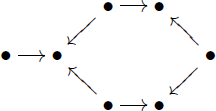
The method described in Section 4 is a degenerate case of this with a cycle of length two. This will lead to Case (iii) of Theorem 1.4.
Let Q be the quiver above, with even cycle length . Then a representation of Q over k consists of vector spaces U,
and
together with k-linear maps
,
,
and
. The case
is illustrated as follows.
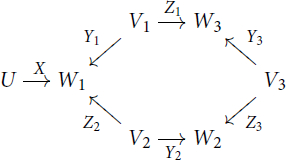
The module has basis vectors
and
. The space U is spanned by
,
is spanned by the
with
, and
is spanned by the
with
. The actions of the arrows are as in Table 2.1, with all
acting like Y and all
acting like Z.
Theorem 6.1.
The endomorphism ring of the kQ-module is equal to k, acting as scalar multiples of the identity map.
Proof.
The proof is the same as for Theorem 2.2. ▪
Proof of Theorem 1.4
in case (iii).
We have kH-modules with
The kH-module B is , and
. This makes B a kH-kQ-bimodule with the property that as a right kQ-module it is a projective generator for
-kQ. The functor
is fully faithful and exact. It sends the simple kQ-modules to the corresponding simple kH-modules. So this time,
is a module of the following form
 where the indices are taken modulo r. ▪
where the indices are taken modulo r. ▪
7 Examples involving one dimensional 
 groups Examples involving one dimensional
groups Examples involving one dimensional 
 groups
groups
In this section, we give examples satisfying Case (iii) of Theorem 1.4.
Example 7.1.
The quiver of the Higman–Sims group HS over a finite splitting field k of characteristic three is as follows.
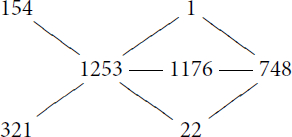
This information comes from Section 2 of Waki [Citation20]. The numbers indicate the dimensions of the corresponding simple modules, and each edge denotes a single arrow in each direction. Choosing the 4-cycle and incoming arrow
, the modules
take the following form.

Example 7.2.
Landrock and Michler [Citation16] showed that the quiver of the principal block of the sporadic Janko group
over the splitting field
is as follows.
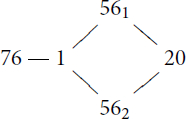
So we can take the 4-cycle and incoming arrow
.
Example 7.3.
For and
, the
quiver was computed in Benson [Citation2] to be as follows.
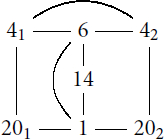
So for example we can take a 4-cycle and incoming arrow
.
Example 7.4.
Computations using Magma [Citation3] exhibit further examples. For the group and
, all the
groups are zero or one dimensional, but the
quiver has a 4-cycle of the form
and an incoming arrow
.
8 The construction
In this section, we show how to pass from the constructions of Sections 2, 4, and 6 and groups satisfying the hypotheses of Theorem 1.4 to examples proving Theorem 1.3. For convenience, we assume that H is a finite simple group, though this could probably be weakened somewhat.
Let k and Q be as in Section 2, 4, or 6. We define the kQ-module to be the colimit of the sequence of modules
This has a basis consisting of the and
with
. Then there are submodules
of
such that
, and
is one dimensional, spanned by the image of
. Namely, we take
to be the submodule spanned by the basis vectors
with
and
with
.
Let and
be the kH-modules defined as the images of
and
under
. Thus
is the colimit of the sequence of modules
The submodules of
satisfy
and
.
We define to be the group consisting of the vector space automorphisms
of
such that
preserves and acts with determinant one on
, and there exists
such that
acts in the same way as h on both
and
. It follows from these conditions that
for all
. Then since
and
, we have
. The action of H on
gives an inclusion
for each m, compatible with these inclusions.
We have group homomorphisms and
given by the actions on
and on
. Since
and
span
, the intersection of the kernels of the actions on these spaces is trivial, so we obtain an injective homomorphism
This is not surjective, because the image of in
stabilises
setwise; but it properly contains
. However, the image contains
, and is therefore the direct product of H and the image in
. The subgroup mapping to
consists of elements acting as
on
and as the identity of
. This subgroup depends on m, and is not the same as the image of
. Indeed, the composite
gives the action of H on the module
.
Lemma 8.1.
The centralizer of the image of is trivial.
Proof.
Let z be an element of . Then z commutes with the action of H on
, and so z acts as a scalar multiple of the identity. But then z also acts on
as a multiple of the identity. The action of
on
factors through
, and
is trivial, so
. ▪
We define to be the colimit of the inclusions
By Theorem 1.4 (3), we have and
.
Theorem 8.2.
The group is isomorphic to a semidirect product
.
Proof.
By the definition of , there is a homomorphism
, taking an element
to the element
that acts on
and
in the same way as
. The composite
is the identity. These homomorphisms are compatible with the inclusions
, and therefore describe a homomorphism
with kernel
a normal complement to the inclusion
. ▪
Theorem 8.3.
Given a finite simple group H satisfying condition (i), (ii) or (iii) of Theorem 1.4, there is an action of H on with trivial centralizer.
Proof.
This follows from Theorem 8.2 and Lemma 8.1. ▪
Proof of Theorem 1.3.
We set in Theorem 8.3. For p odd, we can use Example 5.1, and for
we can use Example 5.2 for the choice of H; there are, of course, many other possible choices. ▪
Acknowledgments
I would like to thank Alexandre Zalesskii for introducing me to these problems at breakfast at the Møller Institute in Cambridge. This was while attending the post Covid-19 resumption of the programme ‘Groups, representations and applications: new perspectives’ in 2022, at the Isaac Newton Institute, supported by EPSRC grant EP/R014604/1. My thanks also go to the Isaac Newton Institute for their support and hospitality.
References
- Andersen, H. H. (1987). Extensions of simple modules for finite Chevalley groups. J. Algebra 111:388–403. DOI: 10.1016/0021-8693(87)90225-0.
- Benson, D. J. (1983). The Loewy structure of the projective indecomposable modules for A8 in characteristic 2. Commun. Algebra 11(13):1395–1432.
- Bosma, W., Cannon, J., Playoust, C. (1997). The Magma algebra system, I. The user language. J. Symbolic Comput. 24:235–265. DOI: 10.1006/jsco.1996.0125.
- Bray, J. N., Wilson, R. A. (2008). Examples of 3-dimensional 1-cohomology for absolutely irreducible modules of finite simple groups. J. Group Theory 11(5):669–673.
- Brescia, M., Russo, A. (2019). On centralizers of locally finite simple groups. Mediterr. J. Math. 16(5):Paper 114, 7pp. DOI: 10.1007/s00009-019-1401-3.
- Ersoy, K., Kuzucuoğlu, M. (2012). Centralizers of subgroups in simple locally finite groups. J. Group Theory 15:9–22.
- Hartley, B. (1990). Centralizing properties in simple locally finite groups and large finite classical groups. J. Austral. Math. Soc. 49:502–513. DOI: 10.1017/S1446788700032468.
- Hartley, B. (1992). Finite and locally finite groups containing a small subgroup with small centralizer. In: Liebeck, M. W., Saxl, J., eds. Groups, combinatorics and geometry, Durham 1990, London Mathematical Society Lecture Note Series, Vol. 165. Cambridge: Cambridge University Press, pp. 397–402.
- Hartley, B. (1995). Simple locally finite groups. In: Hartley, B., Seitz, G. M., Borovik, A. V., Bryant, R. M., eds. Finite and Locally Finite Groups. Berlin/New York: Springer-Verlag, pp. 1–44.
- Hartley, B., Kuzucuoğlu, M. (1991). Centralizers of elements in locally finite simple groups. Proc. London Math. Soc. 62(2):301–324.
- Koshita, H. (1998). Quiver and relations for SL(2,pn) in characteristic p with p odd. Commun. Algebra 26(3):681–712.
- Kuzucuoğlu, M. (1994). Centralizers of semisimple subgroups in locally finite simple groups. Rend. Sem. Mat. Univ. Padova 92:79–90.
- Kuzucuoğlu, M. (1997). Centralizers of abelian subroups in locally finite simple groups. Proc. Edinb. Math. Soc. 40:217–225.
- Kuzucuoğlu, M. (2013). Centralizers in simple locally finite groups. Int. J. Group Theory 2(1):1–10.
- Kuzucuoğlu, M. (2017). Centralizers of finite p-subgroups in simple locally finite groups. J. Siberian Fed. Univ. Math. Phys. 10(3):281–286.
- Landrock, P., Michler, G. O. (1978). Block structure of the smallest Janko group. Math. Ann. 232:205–238. DOI: 10.1007/BF01351427.
- Lübeck, F. (2020). Computation of Kazhdan–Lusztig polynomials and some applications to finite groups. Trans. Amer. Math. Soc. 373(4):2331–2347. DOI: 10.1090/tran/8037.
- Schneider, G. J. A. (1993). The structure of the projective indecomposable modules of the Mathieu group M12 in characteristic 2 and 3. Arch. Math. (Basel) 60:321–326.
- Scott, L. L. (2003). Some new examples in 1-cohomology. J. Algebra 260(1):416–425. DOI: 10.1016/S0021-8693(02)00667-1.
- Waki, K. (1993). The projective indecomposable modules for the Higman–Sims group in characteristic 3. Commun. Algebra 21(10):3475–3487. DOI: 10.1080/00927879308824743.
